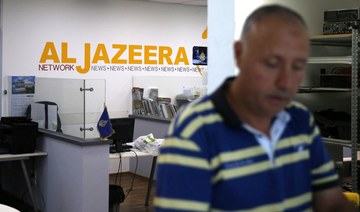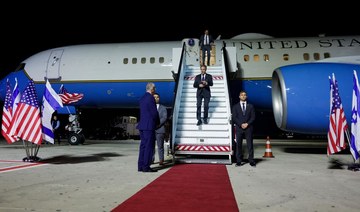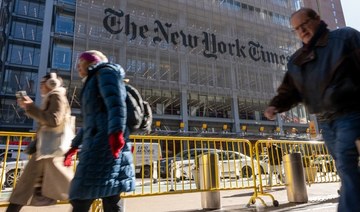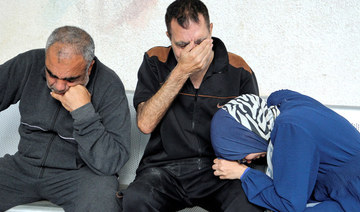TEHRAN: Iran’s former President Akbar Hashemi Rafsanjani’s death on Sunday ended a decades-long career in the ruling elite, where his moderate views were not always welcome but his cunning guided him through revolution, war and the country’s turbulent politics.
The political survivor’s life spanned the trials of Iran’s modern history, from serving as a close aide to Ayatollah Ruhollah Khomeini during the 1979 Islamic Revolution to acting as a go-between in the Iran-Contra deal. He helped found Iran’s contested nuclear program, but later backed the accord with world powers to limit it in exchange for sanctions relief.
Rafsanjani, who showed ruthlessness while in power but later pushed for reforms, died Sunday after suffering a heart attack, state media reported. He was 82.
Iranian media said he was hospitalized north of Tehran earlier Sunday, where doctors performed CPR in vain for nearly an hour and a half before declaring him dead.
A female state newscaster’s voice quivered as she read the news. Rafsanjani, “after a life full of restless efforts in the path of Islam and revolution, had departed for lofty heaven,” she said.
Supreme Leader Ayatollah Ali Khamenei called Rafsanjani an “old friend and comrade” and said his loss is “difficult and life-decreasing.” The government announced three days of mourning, and a funeral was expected to be held on Tuesday.
Rafsanjani served as president from 1989 to 1997, during a period of significant changes in Iran. At the time, the country was struggling to rebuild its economy after a devastating 1980s war with Iraq, while also cautiously allowing some wider freedoms, as seen in Iran’s highly regarded film and media industry.
He also oversaw key developments in Iran’s nuclear program by negotiating deals with Russia to build an energy-producing reactor in Bushehr, which finally went into service in 2011 after long delays. Behind the scenes, he directed the secret purchase of technology and equipment from Pakistan and elsewhere.
War with Iraq
In an interview published in October, Rafsanjani acknowledged the 1980-1988 war with Iraq, which killed some 1 million people, led Iran to consider seeking nuclear weapons.
“Our basic doctrine was always for a peaceful nuclear application, but it never left our mind that if one day we should be threatened and it was imperative, we should be able to go down the other path,” he said. “But we never went.”
The cleric managed to remain within Iran’s ruling theocracy after leaving office, but an attempt to return to the presidency in 2005 was dashed by the electoral victory of the more hard-line Mahmoud Ahmadinejad. Rafsanjani was later branded a dissenter by many conservatives for his harsh criticism of the crackdown that followed Ahmadinejad’s re-election in 2009.
But after years of waning influence, Rafsanjani was handed an unexpected political resurgence with the 2013 victory of a fellow moderate, Hassan Rouhani, giving him an insider role in efforts that would culminate in the 2015 nuclear agreement.
Some analysts believe Rafsanjani was kept within the ruling fold as a potential mediator with America and its allies in the standoff over Iran’s nuclear program. His past stature as a trusted Khomeini ally also offered him political protection. Rafsanjani was a top commander in the war with Iraq and played a key role in convincing Khomeini to accept a cease-fire after years of crippling stalemate.
Dark side
His image, however, also had darker undertones. He was named by prosecutors in Argentina among Iranian officials suspected of links to a 1994 bombing of a Jewish center in Buenos Aires that killed 85 people. Some Iranian reformers accused him of involvement in the slaying of liberals and dissidents during his presidency — charges that he denied and that were never pursued by Iranian authorities.
“The title of Islamic Republic is not just a formality,” he said in 2009 in the chaos after Ahmadinejad’s re-election.
“Rest assured, if one of those two aspects is damaged we will lose our revolution. If it loses its Islamic aspect, we will go astray. If it loses its republican aspect, (the Islamic Republic) will not be realized. Based on the reasons that I have offered, without people and their vote there would be no Islamic system.”
Rafsanjani — a portly man with only sparse and wispy chin hairs in contrast to the full beards worn by most Islamic clerics in Iran — first met Khomeini in the Shiite seminaries of Qom in the 1950s and later became a key figure in the Islamic uprising that toppled the US-backed Shah Mohammad Reza Pahlavi in 1979.
He was elected as head of Iran’s parliament in 1980 and served until 1989, when he was elected for the first of two four-year terms as president.
Here, Rafsanjani began to build his multilayered — and sometimes contradictory — political nature: A supporter of free enterprise, a relative pragmatist toward foreign affairs and an unforgiving leader who showed no mercy to any challenges to his authority.
Economic view
Rafsanjani took a dim view of state control of the economy, even in the turbulent years after the Islamic Revolution, and he encouraged private businesses, development of Tehran’s stock market and ways to boost Iranian exports.
He built roads and connected villages to electrical, telephone and water networks for the first time, earning the title of Commander of Reconstruction by his supporters.
There were certain self-interests at play as well.
Rafsanjani was assumed to be the head of a family-run pistachio business, which grew to become one of Iran’s largest exporters and provided the financial foundation for a business empire that would eventually include construction companies, an auto assembly plant, vast real estate holdings and a private airline. In 2003, he was listed among Iran’s “millionaire mullahs” by Forbes magazine.
His economic policies won him praise from Iran’s elite and merchant classes, but brought bitterness from struggling workers seeking greater state handouts. Rafsanjani also faced warnings from the ruling theocracy about pushing too far. None of his reforms dared to undercut the vast power of the Revolutionary Guard — which Rafsanjani briefly commanded, and which controls every key defense and strategic program.
Rafsanjani’s complex legacy also was shaped by the times.
He took over the presidency in a critical time of transition just after the death of Khomeini. He tried to make overtures for better ties with the US after the American-led invasion of Kuwait in 1991 to drive out Iraqi forces, arguing that Iran paid too high a price for its diplomatic freeze with Washington.
But he could not overcome opposition from Iranian hard-liners and failed to win the backing of Khomeini’s successor as supreme leader, Ayatollah Ali Khamenei, for bold foreign policy moves. He also angered the West by strengthening Iran’s ties to armed groups such as Lebanon’s Hezbollah.
“One of the wrong things we did, in the revolutionary atmosphere, was constantly to make enemies,” he said in a 1987 interview. “We pushed those who could have been neutral into hostility.”
Life as a revolutionary
Rafsanjani was born in 1934 in the village of Bahraman in southeastern Iran’s pistachio-growing region of Rafsanjan.
He was jailed for several years under the shah. He then helped organize the network of mullahs that became Khomeini’s revolutionary underground. In 1965, he is reputed to have provided the handgun for the assassination of Iran’s prime minister, Hassan Ali Mansoor.
Only months after the revolution, Rafsanjani was shot once in the stomach by gunmen from one of the groups vying for power amid the political turmoil. He was not seriously wounded — and neither was his wife, who jumped in front to shield him from the attack.
“Great men of history do not die,” Khomeini said in announcing that Rafsanjani had survived.
During the 1980s, he used his links with Lebanese Shiite extremists to help secure the release of Western hostages in Lebanon and was a key middleman — identified as “Raf” in Pentagon documents — in the secret Iran-Contra dealings to funnel US arms to Iran in exchange for money used to fund Nicaraguan rebels.
Although Rafsanjani was seen by Washington as a potential ice breaker, his views were far from solidly pro-Western and displayed conflicted positions.
Shortly after becoming president in 1989, he hinted that Palestinians should kill Westerners to retaliate for Israeli actions in the occupied territories.
“It is not hard to kill Americans or Frenchmen,” he said.
In February 1994, Rafsanjani survived a second assassination attempt. A lone gunman fired at him as he was speaking to mark the 15th anniversary of the revolution. Unhurt and unshaken, Rafsanjani calmed a crowd of thousands and continued his speech.
Iran-Contra deal
The Iran-Contra fallout is an often-told tale about the dangers of crossing Rafsanjani.
After word was leaked to a Beirut magazine about Rafsanjani’s involvement, he ordered the arrest of the source, a senior adviser to the ruling clerics named Mehdi Hashemi, for treason and other charges. Hashemi and others were executed in September 1987.
Later, however, he was dismayed at the brutal crackdown against opposition groups and others claiming Ahmadinejad won re-election in June 2009 through vote rigging sanctioned by the ruling theocracy.
Khamenei decided to throw his backing behind Ahmadinejad, effectively snubbing Rafsanjani and his complaints. Later, Rafsanjani fell short on efforts to mobilize enough moderate clerics in the Assembly of Experts — the only group with the power to dismiss the supreme leader — to force possible concessions from Khamenei on the postelection clampdowns.
Rafsanjani was forced out of the post in 2011, but remained as head of the Expediency Council, an advisory body that mediates disputes between the parliament and the Guardian Council, a watchdog group controlled by hard-line clerics.
However, his family did not escape so easily. In January 2012, a court sentenced Rafsanjani’s daughter, Faezeh Hashemi, to six months in prison on charges of criticizing the ruling system. A court in 2015 sentenced his younger son, Mahdi, to a 10-year prison term over embezzlement and security charges.
Rafsanjani is survived by his wife, Effat Marashi, and five children.
On Sunday night, Rouhani and others visit the hospital to see Rafsanjani one final time before his body was taken to a mosque ahead of burial.
“He was a revolutionary and freedom-seeking cleric who stuck up for the peoples’ votes,” said Saeed Karimi, a supporter outside the hospital. “It is such a pity that the nation has lost a political leader and guide.”
Others were critical. Maryam Rajavi, president-elect of the Paris-based National Council of Resistance of Iran, said that during Rafsanjani’s term as Iran’s president more Iranian “dissidents were assassinated abroad than any other time in the life of the Islamic Republic.” She said that included the killings of three members of her group.
___
Associated Press writers Jon Gambrell and Adam Schreck in Dubai, United Arab Emirates, and Edith M. Lederer at the United Nations contributed to this report. Biographical material in this story was written by former AP staffer Brian Murphy.
Rafsanjani: Iran leader whose life mirrored nation’s
Rafsanjani: Iran leader whose life mirrored nation’s
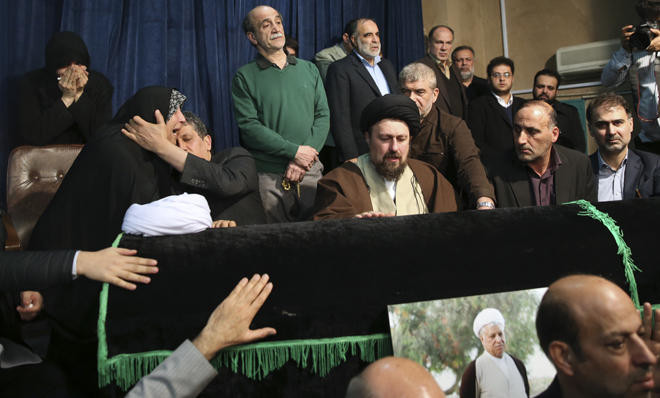
Hamas says it accepts ceasefire proposal of Egypt, Qatar

The group said in a statement that its chief, Ismail Haniyeh, had informed Qatar’s prime minister and Egypt’s intelligence chief of its acceptance of their proposal.
There were no immediate details over what the agreement entailed.
Biden speaks with Netanyahu as Israelis appear closer to Rafah offensive

WASHINGTON: President Joe Biden and Israeli Prime Minister Benjamin Netanyahu spoke Monday morning, a White House official and a National Security Council spokesperson said, as Israel appeared closer to launching an offensive on the southern Gaza city of Rafah — a move staunchly opposed by the US on humanitarian grounds.
The NSC spokesperson said Biden reiterated US concerns about an invasion of Rafah — where more than 1 million civilians from other parts of Gaza are sheltering after 7 months of war sparked by Hamas’ Oct. 7 attack on Israel — and said he believes reaching a ceasefire with Hamas is the best way to protect the lives of Israeli hostages held in Gaza. The officials spoke on the condition of anonymity to discuss the call before an official White House statement was released.
The call comes hours before Biden is to host King Abdullah II of Jordan for a private lunch meeting at the White House on Monday.
On Sunday, Netanyahu rejected international pressure to halt the war in Gaza in a fiery speech marking the country’s annual Holocaust memorial day, declaring: “If Israel is forced to stand alone, Israel will stand alone.”
“I say to the leaders of the world: No amount of pressure, no decision by any international forum will stop Israel from defending itself,” he said, speaking in English. “Never again is now.”
UN experts condemn Israel’s ‘sexual assault and violence’ in Gaza

- Statement pointed to “continued reports of sexual assault and violence against women and girls, including against those detained by Israeli occupation forces”
GENEVA: United Nations experts on Monday condemned “unacceptable” violence by the Israeli military against women and children during the ongoing war in Gaza, particularly sexual violence and enforced disappearances.
“We are appalled that women are being targeted by Israel with such vicious, indiscriminate and disproportionate attacks, seemingly sparing no means to destroy their lives and deny them their fundamental human rights,” the seven special rapporteurs said in a statement.
Special rapporteurs are independent experts appointed by the UN Human Rights Council. They do not speak on behalf of the United Nations.
The statement pointed to “continued reports of sexual assault and violence against women and girls, including against those detained by Israeli occupation forces.”
They cited UN reports saying women and girls in Gaza were victims of enforced disappearances.
Referring to Hamas, which runs the besieged Palestinian territory, Israel’s mission in Geneva alleged the experts had “once again chosen to ignore Hamas’s systematic militarization of health facilities and civilian infrastructures in the Gaza Strip, voluntarily and actively using the population as human shields.”
“In issuing such a statement, the signatories try to create an alternative narrative, parroting the agenda of a terrorist organization that is actively destroying the lives of the Palestinian population in Gaza,” the Israeli mission said.
The bloodiest-ever Gaza war started after an unprecedented attack on southern Israel by militants from Hamas on October 7.
The attack resulted in the deaths of 1,170 people, mostly civilians, according to an AFP tally of Israeli official figures.
Israel’s relentless retaliatory military offensive has killed more than 34,700 people in Gaza — most of them women and children — according to Gaza’s health ministry.
The UN experts said Israel’s widespread destruction of housing in Gaza and the fact that Palestinians were having to live in “precarious” conditions in makeshift tents had a disproportionate impact on women and girls, particularly on their personal security and privacy.
“The treatment of pregnant and lactating women continues to be appalling, with the direct bombardment of hospitals and deliberate denial of access to health care facilities by Israeli snipers,” they added.
More than 180 women per day were giving birth without pain relief, while hundreds of babies have died due to a lack of electricity for incubators, they said.
These conditions have led to a surge in miscarriages, the experts said.
They said Israeli forces had “destroyed Gaza’s largest fertility clinic,” which stored embryos, and estimated that 690,000 women and girls in Gaza were deprived of menstrual hygiene products.
The Israeli mission in Geneva said Israel “categorically rejects unsubstantiated allegations of sexual assaults and violence.”
It said Israel was ready to investigate “any concrete claims of misconduct by its security forces when presented with credible allegations and evidence.”
The UN experts said “the government of Israel has continuously failed to conduct an independent, impartial and effective investigation into the reported crimes.”
‘Where can we go?’ say Rafah residents as Israel demands evacuation
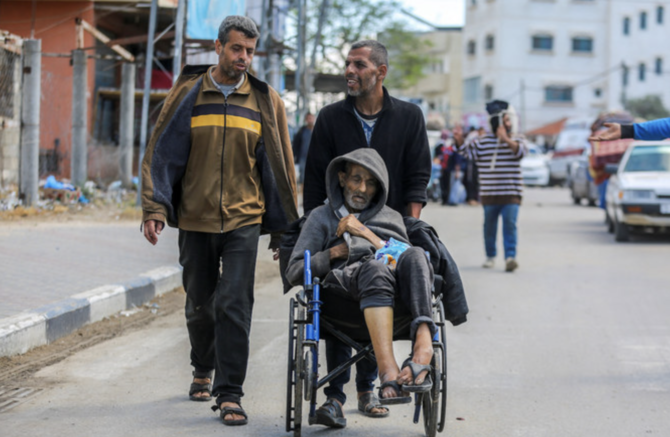
- Areas designated for evacuation currently shelter some 250,000 people
- Israel’s retaliatory offensive, aimed at destroying Hamas, has killed at least 34,683 people in Gaza, mostly women and children
Rafah: Palestinian civilians in the southern Gazan city of Rafah voiced despair on Monday as Israel dropped fliers urging them to evacuate for their own “safety” ahead of a “limited” military operation.
Israel’s army said it was instructing Palestinian families in eastern Rafah to flee in preparation for an expected ground assault on the city which abuts Gaza’s border with Egypt.
Residents of Rafah described emerging outside after a terrifying night in which around a dozen air strikes were carried out on Rafah, to find fliers falling from the sky telling them to “evacuate immediately.”
“The army is working with intensive power against the terrorist forces near you,” read a flier circulated in eastern Rafah.
“For your safety, the IDF (Israeli military) tells you to evacuate immediately toward the expanded humanitarian zone of Al-Mawasi,” it said, with a map indicating the location to the north of Rafah.
Osama Al-Kahlout, of the Palestinian Red Crescent Society in Gaza, told AFP that the areas designated for evacuation currently shelter some 250,000 people, many of whom have already been displaced from other areas in the Gaza Strip.
“The evacuation process has begun on the ground, but in a limited manner,” he said.
An Israeli militark spokesman, when asked how many people should move, said: “The estimate is around 100,000 people.”
About 1.2 million people are currently sheltering in Rafah, according to the World Health Organization, most having fled there during the seven-month war between Israel and Hamas Palestinian militants.
Amid pouring rain, some of those sheltering in Rafah said they had begun packing up their things from the densely packed tents and preparing to leave even before Israel’s directive arrived.
“Whatever happens, my tent is ready,” a resident told AFP.
But others said the area they were being told to flee to was already overcrowded, and they did not trust that it would be safe.
Abdul Rahman Abu Jazar, 36, said he and 12 family members were in the designated evacuation area.
Jazar and his family did not know what to do, he said, because the “humanitarian zone” they were told to head for “does not have enough room for us to make tents because they are (already) full of displaced people.”
“Where can we go? We do not know,” he told AFP.
“There are also no hospitals and it is far from any services many need,” he said, adding that one of his family members relied on dialysis at the Al-Najar hospital, in the area of Rafah instructed to evacuate.
“How will we deal with her after that? Should we watch her die without being able to do anything?“
An Israeli military spokesman told reporters that the evacuation “is part of our plans to dismantle Hamas ... we had a violent reminder of their presence and their operational abilities in Rafah yesterday.”
On Sunday, four Israeli soldiers were killed and others wounded, the army said, when a barrage of rockets was fired toward the Kerem Shalom border crossing between Israel and Gaza.
The army said the rockets were fired from an area adjacent to Rafah.
International aid organizations have voiced alarm at the expected invasion of Rafah.
“From the humanitarian perspective, no credible humanitarian plan for an attack on Rafah exists,” said Bushra Khalidi, advocacy director for Oxfam in the Palestinian territories.
She said she could “not fathom that Rafah will happen,” asking where displaced Palestinians will go “when most of their surroundings have been reduced to death and rubble?“
Gaza’s bloodiest-ever war broke out following Hamas’s unprecedented October 7 attack on Israel which resulted in the deaths of more than 1,170 people, mostly civilians, according to an AFP tally of Israeli official figures.
Militants also seized some 250 hostages, with Israel estimating that 128 of them remain in Gaza, including 35 whom the military says are dead.
Israel’s retaliatory offensive, aimed at destroying Hamas, has killed at least 34,683 people in Gaza, mostly women and children, according to the Hamas-run territory’s health ministry.
US weapon system identified in Israeli-Lebanon strike may breach international law

- Guardian investigation with Human Rights Watch identifies Boeing-made Joint Direction Attack Munition fragments at site where aid workers were killed
- US bans export of such systems to foreign militaries where ‘credible information’ of human rights breaches exists
LONDON: An Israeli airstrike in Lebanon that killed seven aid workers in March may have been conducted with a US-supplied weapon system, according to an investigation by The Guardian.
The incident claimed the lives of seven paramedics aged 18-25, all volunteers, at an ambulance center in Al-Habariyeh in southern Lebanon on March 27.
It came five days before an Israeli strike in Gaza killed seven aid workers working for World Central Kitchen.
Debris found at the scene in Al-Habariyeh was identified by The Guardian, an independent expert and Human Rights Watch as having belonged to a 500-pound Israeli MPR bomb and a Boeing-made Joint Direction Attack Munition, a system attached to explosives to turn them from “dumb bombs” into GPS-guided weapons.
HRW’s Lebanon researcher Ramzi Kaiss told The Guardian: “Israel’s assurances that it is using US weapons lawfully are not credible. As Israel’s conduct in Gaza and Lebanon continues to violate international law, the Biden administration should immediately suspend arms sales to Israel.”
The US government is legally unable to help or arm foreign militaries where “credible information” of human rights abuses exists, under the terms of the 1997 Leahy law.
A spokesperson for the US National Security Council told The Guardian: “The US is constantly working to ensure defense articles provided by the US are being used consistent with applicable domestic and international law. If findings show violations, we take action.”
But Josh Paul, a non-resident fellow with Democracy for the Arab World Now and a former State Department employee, said: “The State Department has approved several of these (weapons) transfers on a 48-hour turnaround. There is no policy concern on any munitions to Israel other than white phosphorus and cluster bombs.”
He added that JDAMs have been “key items” regularly requested by Israel since the start of the Gaza war.
Secretary of State Antony Blinken will deliver a report on Wednesday to Congress on Israel’s use of American weapons and whether they may have been involved in violations of this or other laws.
Maryland Sen. Chris Van Hollen told The Guardian that the findings from Al-Habariyeh are “deeply concerning and must be fully investigated by the Biden administration, and their findings should certainly be included in the NSM-20 report that is due to be submitted to the Congress on May 8.”
The airstrike on the ambulance center in Al-Habariyeh came without warning before 1 a.m. on March 27. No fighting had been reported in the area.
The victims had been at the center for the night shift, and were named as twin brothers Hussein and Ahmad Al-Shaar, aged 18; Abdulrahman Al-Shaar, 19; Mohammad Hamoud, 21; Mohammad Al-Farouk Aatwi, 23; Abdullah Aatwi, 24; and Baraa Abu Kaiss, 24.
The Israeli military claimed that the strike, which leveled the two-storey building, killed a “prominent terrorist belonging to Jamaa Islamiya,” an armed Lebanese political group with ties to Hezbollah. It did not identify the person by name.
A Jamaa Islamiya spokesman acknowledged that some of the ambulance volunteers were members of the group, but denied that they were part of its armed wing.
Samer Hardan, head of the local Civil Defense center who was among the first responders, told The Guardian: “We examined every centimetre looking for parts of bodies and their possessions. We saw nothing military-related. We knew (the victims) personally, so we could identify their remains.”
Since Oct. 7, 16 medical workers have been killed by Israeli airstrikes in Lebanon, and a further 380 people have died including 72 civilians. Eleven Israeli soldiers and eight civilians have also been killed.
Kassem Al-Shaar, father of Ahmad and Hussein, said he had warned his sons not to volunteer.
“I told them that it was dangerous to do this type of work, but they said that they accepted the risk. I don’t know what Israel was thinking — these were young people excited to help others,” he said.
“My sons wanted to do humanitarian work, and look what happened to them. Israel wouldn’t dare to do what they did if it wasn’t for the US standing behind them.”


